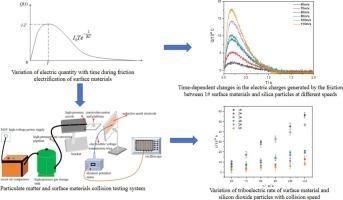The study of the calculation method of the triboelectric rate of particles and surface materials at different collision velocities
IF 4.5
2区 工程技术
Q2 ENGINEERING, CHEMICAL
引用次数: 0
Abstract
In this paper, a triboelectric rate calculation model based on the relative collision velocity between the material and the particle is put forward. The model demonstrates distinct trends of the triboelectrification rate's increase with velocity, ranging from a 9/5 power to a linear function increase. Meanwhile, a test system is devised to simulate the high-speed collision process between ions and materials, and the derived model is validated through experiments.

不同碰撞速度下颗粒和表面材料的三电率计算方法研究
本文提出了一种基于材料和粒子之间相对碰撞速度的三电化率计算模型。该模型显示了三电化率随速度增加的明显趋势,从 9/5 次方到线性函数增加。同时,还设计了一个测试系统来模拟离子与材料之间的高速碰撞过程,并通过实验对推导出的模型进行了验证。
本文章由计算机程序翻译,如有差异,请以英文原文为准。
求助全文
约1分钟内获得全文
求助全文
来源期刊

Powder Technology
工程技术-工程:化工
CiteScore
9.90
自引率
15.40%
发文量
1047
审稿时长
46 days
期刊介绍:
Powder Technology is an International Journal on the Science and Technology of Wet and Dry Particulate Systems. Powder Technology publishes papers on all aspects of the formation of particles and their characterisation and on the study of systems containing particulate solids. No limitation is imposed on the size of the particles, which may range from nanometre scale, as in pigments or aerosols, to that of mined or quarried materials. The following list of topics is not intended to be comprehensive, but rather to indicate typical subjects which fall within the scope of the journal's interests:
Formation and synthesis of particles by precipitation and other methods.
Modification of particles by agglomeration, coating, comminution and attrition.
Characterisation of the size, shape, surface area, pore structure and strength of particles and agglomerates (including the origins and effects of inter particle forces).
Packing, failure, flow and permeability of assemblies of particles.
Particle-particle interactions and suspension rheology.
Handling and processing operations such as slurry flow, fluidization, pneumatic conveying.
Interactions between particles and their environment, including delivery of particulate products to the body.
Applications of particle technology in production of pharmaceuticals, chemicals, foods, pigments, structural, and functional materials and in environmental and energy related matters.
For materials-oriented contributions we are looking for articles revealing the effect of particle/powder characteristics (size, morphology and composition, in that order) on material performance or functionality and, ideally, comparison to any industrial standard.
 求助内容:
求助内容: 应助结果提醒方式:
应助结果提醒方式:


